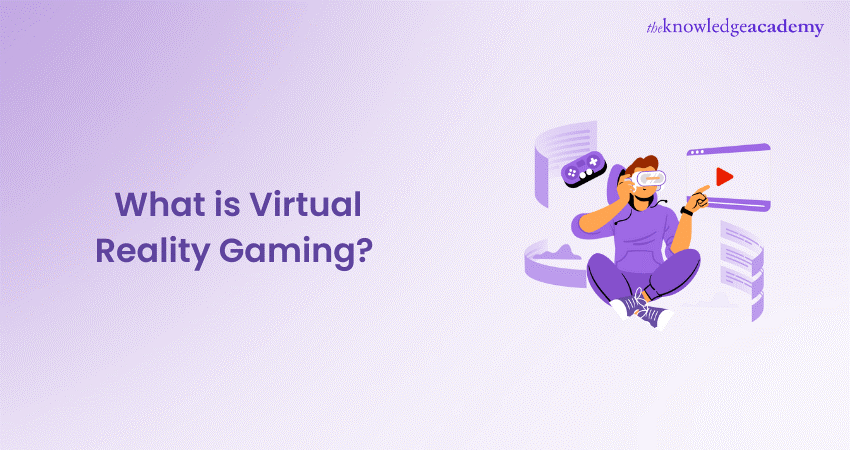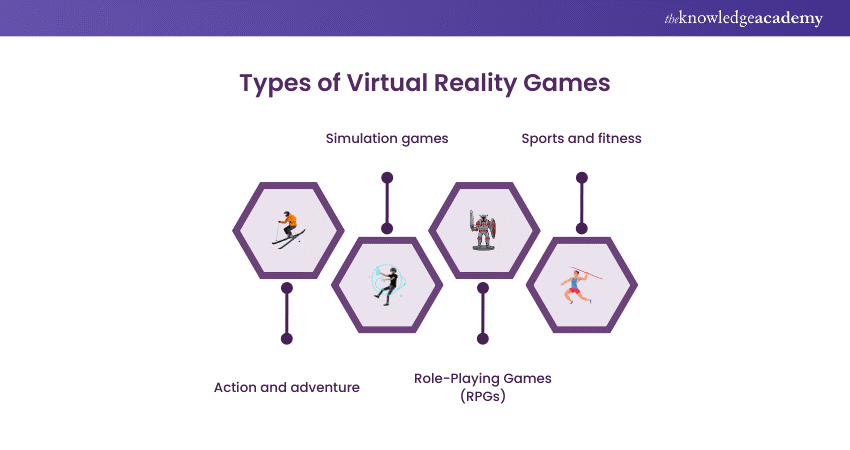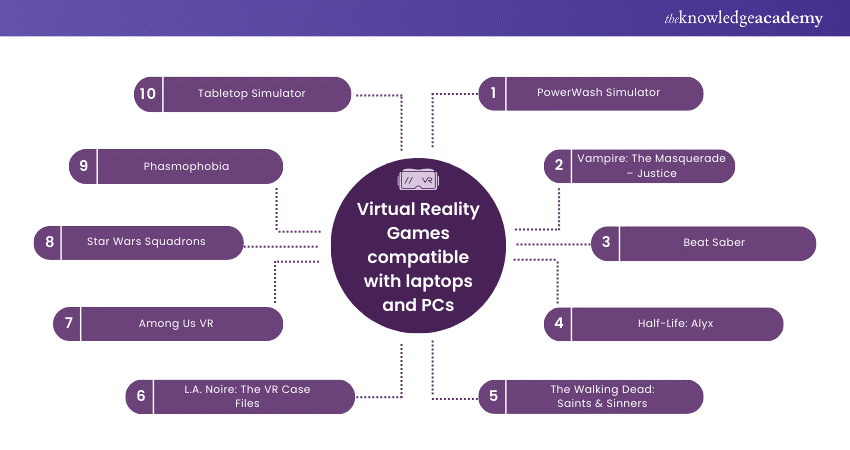We may not have the course you’re looking for. If you enquire or give us a call on +08000201623 and speak to our training experts, we may still be able to help with your training requirements.
Training Outcomes Within Your Budget!
We ensure quality, budget-alignment, and timely delivery by our expert instructors.

The concept of Virtual Reality gaming began to take shape during the era when games like Grand Theft Auto: Vice City and Counter-Strike captured the hearts of gamers worldwide. Witnessing the immense success of these video games, developers started contemplating the next big thing for the gaming community. What did they envision? The answer lies in Virtual Reality (VR) Gaming.
VR Gaming represents a fusion of cutting-edge immersive technology and standard video game graphics, creating a compelling illusion of a three-dimensional environment. In this immersive world, users can transform their homes into personal virtual playgrounds, complete with high-resolution images, compatible VR hardware, and a connection to VR visualisation software. It's a thrilling evolution that invites gamers to step beyond the screen and experience their favorite games in an entirely new dimension.
Table of Contents
1) What is Virtual Reality Gaming?
2) Evolution of Virtual Reality Gaming
3) How does Virtual Reality Gaming work?
4) Various types of Virtual Reality games
5) Accessory for Virtual Reality Gaming
6) Conclusion
What is Virtual Reality Gaming?
Virtual Reality Gaming involves applying a three-dimensional (3D) artificial environment to computer games. VR environments are crafted using VR software and presented to the user in a manner that surpasses the real-world setting, fostering suspension of disbelief and allowing users to perceive the VR environment as authentic.
Players can play VR games on smartphones, PCs, laptops, and Gaming consoles. Control in Virtual Reality Gaming can encompass a standard keyboard and mouse, game controllers, and motion capture methods.
Advanced VR setups might incorporate features like treadmill floors or similar techniques to enhance the user's sense of movement freedom and immersion. In some VR configurations, users may be restricted to a defined area around a computer but enjoy unrestricted motion within that space.
Evolution of Virtual Reality Gaming
Virtual Reality Gaming represented a logical progression from traditional video and 3D games. Before the advent of compact VR technology, Gaming in Virtual Reality involved dedicated projector rooms equipped with multiple screens and projectors.
Key milestones in the evolution of Virtual Reality Gaming include:
1) In 1962, cinematographer Morton Heilig introduced the Sensorama, which is considered the first VR machine. It was a booth that accommodated multiple individuals, offering a fully immersive movie experience with audio, 3D videos, vibrations, and scent. Heilig secured a patent for this innovation in the same year.
2) Computer scientist Ivan Sutherland envisioned the Ultimate Display in 1965, describing a room where a computer-controlled the existence of matter, incorporating interactive graphics and force-feedback controller capabilities.
3) In 1968, Sutherland developed the Sword of Damocles, a head-mounted device presenting 3D models that adjusted perspective based on the user's head movements.
4) In the 1980s, computer scientist Jaron Lanier popularised "Virtual Reality" and founded VPL in 1984, the first company to sell VR technology. The DataGlove, allowing users to manipulate virtual objects, was among VPL's innovations.
5) The commercialisation of Virtual Reality Gaming gained traction in 1989 with the release of the Power Glove for the Nintendo Entertainment System. This consumer-grade device drew inspiration from VPL's DataGlove.
6) Nintendo's Virtual Boy console in 1995 attempted to introduce VR with a headset displaying stereoscopic 3D graphics. However, it faced commercial challenges due to the complexity and cost of creating consumer-grade VR products.
7) In 2010, Palmer Luckey developed the Oculus Rift prototype, which was released commercially in 2016. Marketed as an affordable option for Virtual Reality Gaming, it influenced the development of other VR products, such as PlayStation VR and the HTC Vive.
8) In 2019, Oculus Quest, a division of Meta, introduced the Oculus Quest headset. Facebook's investment in Reality Labs and metaverse development furthered the integration of VR technology.
9) The metaverse concept gained popularity in 2021 as Meta developed ways for users to socialise and play games within it, driving increased interest and investment in VR technology for corporate applications.
Explore cutting-edge technologies with our Advanced Technologies Courses for a future-ready skill set. Elevate your expertise today!
How does Virtual Reality Gaming work?
VR Gaming systems consist of both software and hardware components. The games are crafted to provide an immersive experience, aiming to engage users with a world beyond their physical surroundings. These systems are meticulously engineered to minimise latency, ensuring swift and precise feedback based on users' actions.
VR Gaming systems generate lifelike sensations, creating an illusion of users being physically present in a digitally generated environment. The primary objective of VR Gaming is to convincingly transport users into a virtual realm, allowing them to navigate and interact with digital features and objects.
In its most basic form, a VR Game presents a 3D image that users can explore interactively on a computing device by manipulating keys, a mouse, or a touchscreen. Virtual Reality commonly employs a head-mounted display with a screen enveloping the eyes. Additionally, specially designed rooms with multiple projectors and expansive screens are utilised in these systems.
Various types of Virtual Reality games
Virtual Reality games span an extensive range of genres and experiences, exploiting the immersive potential of VR technology to offer users unparalleled virtual adventures. Here's a comprehensive exploration of the myriad types:

1) Action and adventure: Immerse yourself in heart-pounding action and adventure with VR games that transport players to fantastical worlds. Experience adrenaline-pumping scenarios and engage in intense combat, all within a fully immersive 3D space.
2) Simulation games: VR simulation games recreate real-world experiences, allowing users to step into various roles virtually. From flight simulations to driving experiences, these games provide a realistic and interactive feel, enhancing the sense of presence.
3) Role-Playing Games (RPGs): Explore epic narratives and fantasy realms in VR RPGs. Players can inhabit characters, embark on quests, and interact with a dynamic virtual world, offering a profoundly engaging and personalised storytelling experience.
4) Sports and fitness: VR extends its reach into sports and fitness, offering virtual environments for activities like tennis, boxing, and fitness routines. Users can enjoy an active and dynamic Gaming experience, promoting physical movement.
Beyond these genres are individual VR games and multiplayer online VR games catering to diverse preferences. Some VR games thrust players into physical combat environments, while others involve less confrontational pursuits like auto racing and acrobatic flying.
Certain VR games challenge players, either solo or in collaboration, to solve problems, manipulate objects, or explore new virtual realms. This dynamic landscape ensures a rich and varied VR Gaming experience for users worldwide.
Explore the future of technology with our Introduction to Virtualisation Technologies Course. Join now for advanced skills and hands-on expertise!
Virtual Reality games compatible with laptops and PCs
Games experienced on high-performance computers offer the utmost in intricate virtual environments and diverse Gaming choices. Opting for top-tier hardware ensures a detailed and immersive Virtual Reality (VR) experience. Some standout VR games that have garnered acclaim include:

1) PowerWash Simulator
2) Vampire: The Masquerade – Justice
3) Beat Saber
4) Half-Life: Alyx
5) The Walking Dead: Saints & Sinners
6) L.A. Noire: The VR Case Files
7) Among Us VR
8) Star Wars Squadrons
9) Phasmophobia
10) Tabletop Simulator
Virtual Reality games available on game consoles
Games in the Virtual Reality (VR) genre designed for game consoles share similarities with those played on Personal Computers (PCs). However, they are exclusively compatible with game consoles produced by specific manufacturers. A prominent illustration of this is the PlayStation VR headset and platform.
Virtual Reality games for smartphones
For mobile VR Gaming, smartphone makers are rolling out their unique headsets, controllers, and games encompassing Virtual Reality (VR), Augmented Reality (AR), and Mixed Reality (MR). An example of this is the Samsung Gear VR headset and platform.
Accessory for Virtual Reality Gaming
In Virtual Reality (VR) Gaming, participants actively engage with and shape the Gaming environment through various VR Gaming devices and accessories. These include, but are not limited to, VR headsets, sensor-equipped gloves, hand controllers, and various other immersive peripherals.
The flexibility of VR Gaming extends across multiple platforms, accommodating diverse preferences and Gaming setups. Players can choose their preferred Gaming environment, whether on standalone systems, specialised game consoles, or high-performance laptops and PCs capable of supporting premier VR headsets like Oculus Rift and HTC Vive.
VR Gaming is not confined solely to its traditional form. Fascinating subsets incorporate technologies like Augmented Reality (AR) and Mixed Reality (MR). In these instances, virtual elements are seamlessly integrated into the player's real-world surroundings as observed through a headset or camera.
For example, the Lenovo Explorer utilises the Windows Mixed Reality platform, adding a layer of versatility to the experience. While still rooted in VR, this platform introduces novel AR and MR encounters, broadening the spectrum of possibilities for immersive gameplay.
Virtual Reality headsets and glasses
The crucial accessory in VR Gaming is the device worn on your head that immerses you in the Gaming experience. The category of headsets and goggles is rapidly expanding, offering a diverse range of products. This spans from high-end motion-control VR headsets that capture and transmit complete head and eye movements to simpler VR goggles that showcase the simulated 3D game environment.
VR Game controllers
An integral part of the VR Gaming experience, a VR controller translates your physical actions into in-game performance. Like traditional video games, most VR games use hand-based controllers such as joysticks, gamepads, or gloves for movements like pointing, firing, and issuing commands. More sophisticated VR games incorporate motion detectors/controllers to sense real-life activities like walking or throwing, recreating them within the virtual environment.
VR Gaming gloves
The advent of sensor-equipped VR Gaming gloves has ushered in a new level of intricacy in the latest VR games. While VR motion detectors can capture broad, whole-body movements, VR gloves bring precision by detecting subtle hand and finger movements. This capability allows developers to create a new generation of VR games that involve tasks like picking up small items, grasping and carrying objects, and more.
Transform your expertise in Virtual Reality with our comprehensive Virtual Reality (VR) Training. Sign up now!
Conclusion
In conclusion, while Virtual Reality Gaming has gained significant traction, there remains a need for continued research and innovation on the creative front. The evolution of VR is not solely dependent on its rising popularity but also hinges on advancements in creativity and content creation. By addressing these aspects, the industry can further refine the canvas of Virtual Reality Gaming, ensuring a more immersive and enduring experience for users.
Frequently Asked Questions

Virtual Reality (VR) Gaming is an immersive and interactive digital experience that transports players into a three-dimensional, computer-generated environment. Using specialised VR headsets and accessories, players can engage with and navigate through realistic virtual worlds, often simulating a range of sensory experiences. This technology aims to create an environment where users feel physically present in the digital space, enhancing the overall gaming experience.

Virtual Reality Gaming operates through a combination of advanced hardware and software. Players wear VR headsets that contain high-resolution displays and motion sensors, tracking head movements and providing a stereoscopic 3D view. Dedicated VR controllers or gloves enable users to interact with the virtual environment, translating real-world movements into in-game actions. The seamless integration of these components creates an immersive experience where players can explore, interact, and engage in a way that goes beyond traditional gaming.

Virtual Reality Gaming offers several advantages, including enhanced immersion, heightened sensory experiences, and a more interactive gameplay environment. It provides a novel way to experience gaming by making users feel present within the virtual world, fostering a deeper connection with the game narrative. VR Gaming can contribute to improved spatial awareness and hand-eye coordination and offers an innovative platform for social interactions through multiplayer experiences, making it a transformative and exciting evolution in the gaming industry.

The Knowledge Academy takes global learning to new heights, offering over 30,000 online courses across 490+ locations in 220 countries. This expansive reach ensures accessibility and convenience for learners worldwide.
Alongside our diverse Online Course Catalogue, encompassing 17 major categories, we go the extra mile by providing a plethora of free educational Online Resources like News updates, blogs, videos, webinars, and interview questions. Tailoring learning experiences further, professionals can maximise value with customisable Course Bundles of TKA.

The Knowledge Academy offers various Advanced Technologies Courses, including Introduction To Virtualisation Technologies, Internet Of Things IoT Systems And Applications Training, etc. These courses cater to different skill levels, providing comprehensive insights into What is the Metaverse?.
Our Advanced Technology blogs cover a range of topics related to Virtual Reality, offering valuable resources, best practices, and industry insights. Whether you are a beginner or looking to advance your Advanced Technology skills, The Knowledge Academy's diverse courses and informative blogs have you covered.

The Knowledge Academy’s FlexiPass is a pre-paid training voucher that is built specifically for clients and their dynamic needs. It provides access to a wide range of courses at a pre-determined price, with robust safety measures. FlexiPass gives clients the added benefit of upskilling on a budget that best fits them.
Upcoming Advanced Technology Resources Batches & Dates
Date
 Virtual Reality (VR) Training
Virtual Reality (VR) Training
Fri 17th Jan 2025
Fri 21st Feb 2025
Fri 4th Apr 2025
Fri 6th Jun 2025
Fri 25th Jul 2025
Fri 7th Nov 2025
Fri 26th Dec 2025







 Top Rated Course
Top Rated Course



 If you wish to make any changes to your course, please
If you wish to make any changes to your course, please


